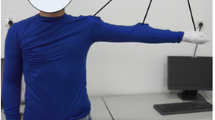Abstract
There are diverse types of devices based on natural user interface/experience for humanized computing. One such device, the MYO allows the measurement of arm motions and uses them as an interface based on gestures. There are several research works for measuring the arm motions using MYOs. For example, one of the studies defines two types of motions for a forearm and for an upper arm, respectively. The orientations of the two types are measured by two MYOs. Bayesian probabilities are calculated based on the measured orientations and are utilized to estimate the orientations of the upper arm that is not being measured. However, because the orientation of the MYO can be expressed by one quaternion, the Bayesian probability by quaternions is more accurate than the Bayesian probability by each element of quaternions. This paper proposes a motion estimation method to increase the accuracy of motion estimation. The orientations obtained from MYO are expressed by one quaternion and are clustered by K-means. In the experiments, the performance of the proposed method was validated by analyzing the difference between estimated motion quaternions and measured motion quaternions, which showed enhanced performance.











Similar content being viewed by others
References
Bang G, Yang J, Kyoungsu O, Ko I (2017) Interactive experience room using infrared sensors and user’s poses. J Inf Process Syst 13(4):876–892. https://doi.org/10.3745/jips.02.0068
Chae J, Jin Y, Sung Y, Cho K (2018a) Genetic algorithm-based motion estimation method using orientations and EMGs for robot control. Sensors 18(1):1–14
Chae J, Jin Y, Wen M et al (2018b) Genetic algorithm-based adaptive weight decision method for motion estimation framework. J Supercomput. https://doi.org/10.1007/s11227-018-2247-3
Jim Belk. https://math.stackexchange.com/users/1726/jim-belk. Quaternion distance (version: 2011-12-10). https://math.stackexchange.com/q/90098
Khademi M, Hondori HM, McKenzie A, Dodakian L, Lopes CV, Cramer SC (2014) Free-hand interaction with leap motion controller for stroke rehabilitation. In: CHI extended abstracts, pp 1663–1668
Kim A-R, Rhee S-Y (2013) Mobile robot control using kinect sensor and smartphone. Proc KIIS Spring Conf 23(1):133–134
Kim PY, Sung Y, Park JH (2015) Bayesian probability-based motion estimation method in ubiquitous computing environments. Lecture Notes in Electrical Engineering, vol 373, pp 593–600
Kim J, Chung D, Ko I (2017) A climbing motion recognition method using anatomical information for screen climbing games. Hum Centric Comput Inf Sci 7:25
Ko SY, Bang W-C, Kim S-Y (2010) A measurement system for 3D hand-drawn gesture with a PHANToM device. J Inf Process Syst 6(3):347–358. https://doi.org/10.3745/JIPS.2010.6.3.347
Kwak J, Park JH, Sung Y (2016) Unmanned aerial vehicle flight point classification algorithm based on symmetric big data. Symmetry-basel 9(1):1
Lee S-B, Jung I-H (2014) A design and implementation of natural user interface system using kinect. J Digit Contents Soc 15(4):473–480
Lee JK, Kang WM, Park JH, Kim JS (2014) GWD: gesture-based wearable device for secure and effective information exchange on battlefield environment. J Converg 5(4):6–10
Lee SG, Sung Y, Park JH (2016) Motion estimation framework and authoring tools based on MYOs and Bayesian probability. Multimedia Tools Appl, 1–20
Li W, Zhang Z, Liu Z (2010) Action recognition based on a bag of 3D points. In: Proceedings of IEEE computer vision and pattern recognition—workshops, IEEE Press, pp 9–14
Majoe D, Widmer L, Tschiemer P, Gutknecht J (2009) Tai Chi motion recognition, embedding the HMM method on a wearable. In: IEEE, pp 339–344
Ng CK, Fam JG, Ee GK, Noordin NK (2013) Finger triggered virtual musical instruments. J Converg 4(1):39–46
Nymoen K, Haugen MR, Jensenius AR (2015) MuMYO—evaluating and exploring the MYO armband for musical interaction. In: International conference on new interfaces for musical expression, pp 1–4
Potter LE, Araullo J, Carter L (2013) The leap motion controller: a view on sign language. In: OZCHI, pp 175–178
Sathiyanarayanan M, Mulling T (2015) Map navigation using hand gesture recognition: a case study using MYO connector on Apple Maps. In: Procedia computer science, pp 50–57
Sathiyanarayanan M, Rajan S (2016) Myo armband for physiotherapy healthcare: a case study using gesture recognition application. In: Communication systems and networks (COMSNETS) 2016 8th international conference, pp 1–6
Schlömer T, Poppinga B, Henze N, Boll S (2008) Gesture recognition with a Wii controller. In: Tangible and embedded interaction, pp 11–14
Song W, Liu L, Tian Y, Sun G, Fong S, Cho K (2017) A 3D localisation method in indoor environments for virtual reality applications. Hum Centric Comput Inf Sci 7:39
Suh D (2015) A study on interactive video installation based on kinect with continuous silhouette line drawings of body movements—based on the work. J Korean Soc Media Arts 13(1):119–132
Wei W, Yunxiao A (2009) Vision-based human motion recognition: a survey. In: 2009 Second international conference on intelligent networks and intelligent systems, pp 386–389
Weichert F, Bachmann D, Rudak B, Fisseler D (2013) Analysis of the accuracy and robustness of the leap motion controller. Sensors 13(5):6380–6393
Acknowledgements
This research was supported by the MSIT (Ministry of Science and ICT), Korea, under the ITRC (Information Technology Research Center) support program (IITP-2017-2013-0-00684) supervised by the IITP (Institute for Information & communications Technology Promotion).
Author information
Authors and Affiliations
Corresponding author
Ethics declarations
Conflict of interest
The authors declare that they have no conflict of interest.
Additional information
Communicated by G. Yi.
Rights and permissions
About this article
Cite this article
Sung, Y., Guo, H. & Lee, SG. Motion quaternion-based motion estimation method of MYO using K-means algorithm and Bayesian probability. Soft Comput 22, 6773–6783 (2018). https://doi.org/10.1007/s00500-018-3379-3
Published:
Issue Date:
DOI: https://doi.org/10.1007/s00500-018-3379-3




